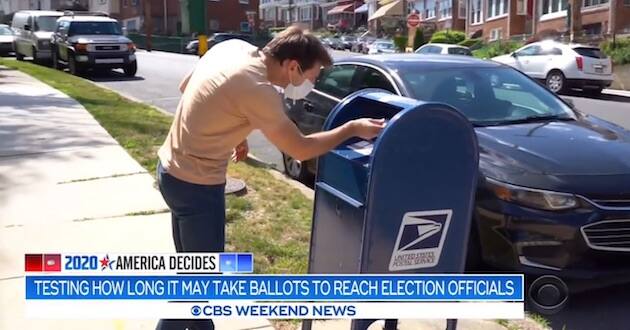What you need to know about mail-in voting debate

Recent incidents of massive mail-in vote problems continue to give many Americans on both sides of aisle reason to worry. When twenty percent of all mail-in votes in New Jersey’s third largest city are invalidated, as they were this summer, it inevitably makes headlines.
It is just one of many recent high-profile incidents of significantly delayed ballots and other electoral mishaps drawing attention to problems associated with voting-by-mail. Those incidents include mail-in ballots being left in bulk at apartment house mailboxes, Postal Service workers dumping ballots in the trash and post offices losing thousands of pieces. In one CBS News investigation, three percent of test ballots were lost. That may not seem like a lot but many elections are decided by less than three percent, including the last presidential election.
These incidents are lending fuel to the fire over doubts of using mail-in voting in the Nov. 3 presidential election. Now, even national media outlets like CBS News, which did their own investigation, are grudgingly acknowledging the mass problems.
President Donald Trump has spoken out against voting-by-mail, saying it lacks many of the safeguards of voting in person and can lead to big delays in arriving at an election’s final result.
“If you do universal mail-ins with millions and millions of ballots, you are never going to know what the real result of an election is,” Trump said last month. “It’s going to be a very, very sad day for our country.”
Not all Republican officeholders are on board with Trump’s attacks on mail-in balloting.
Rohn Bishop, chairman of the GOP in Fond du Lac County, Wisconsin, told CNN last month that Republicans were “begging our voters” to vote absentee when the COVID-19 pandemic hit. Then the president began tweeting against voting-by-mail “and we dropped the issue like a hot potato.”
“Our voters are running away from it. That kind of terrifies me.”
On the other hand, Democrats are pushing hard for universal voting-by-mail, saying it’s too dangerous for voters to appear at polling stations during the current pandemic, even while voters seem fine showing up at the local Walmart or Home Depot to shop.
“People should not have to choose between their health and their vote, and that’s very important,” House Speaker Nancy Pelosi (D-Calif.) said recently.
The Supreme Court has even been pulled into the battle over voting-by-mail.
In early July, the high court temporarily blocked, on a 5–4 vote, a lower court’s order that would have made it easier for residents of three Alabama counties to vote by absentee ballot in July 14 primary runoff elections.
Post Office
Some observers are concerned about whether a government agency, the U.S. Postal Service, long-criticized for its lack of efficiency, can handle an unprecedented onslaught of mail-in-ballots.
“Even if there are error rates by the United States Postal Service of a couple of percent, we are talking about millions of ballots,” John R. Lott Jr., president of the Crime Prevention Research Center, a think tank headquartered in Alexandria, Virginia, told The Epoch Times.
“An audit of the 2018 election by the USPS found that the share of election and political mail that was delivered on time averaged 84.2 percent” in the seven lowest-performing distribution centers, including suburban Maryland, Eau Claire, Wisconsin, and Royal Palm, Florida, he said.
“With the surge in election-related mail that is going to occur this year, that percent would be a disaster, involving tens of millions of votes.”
The USPS report, issued by the agency’s inspector general, found that high-performing locations such as Seattle; Norfolk, Virginia; and Southern Maine, averaged 99.6 percent on-time delivery of electoral and political mail.
“Democrats are claiming that President Trump is trying to sabotage the postal system, but this audit was done long before mail-in ballots became an issue this year,” Lott said.
Mail-In Doubled
On the other hand, Donny Ferguson, who has worked as a campaign consultant for Republican candidates, is bullish on voting-by-mail. He said Republicans are unduly fearful of voting-by-mail, a method of casting ballots that can be a net plus if approached correctly. Ferguson is a former congressional aide, and president of Americans for a Better Economy, an Alexandria, Virginia-based nonprofit organization.
“There may be some glitches and slowdowns with increased mail-in ballots, but even before all this, early voting was approaching almost half of all votes cast, and most it is mail-in voting, which is increasing,” he told The Epoch Times.
A report by the U.S. Election Assistance Commission after the 2016 elections found that the “total number of voters who voted early, absentee, or by mail more than doubled from 24.9 million in 2004 to 57.2 million in 2016, representing an increase from one in five of all ballots cast to two in five of all ballots cast.”
In-person voting is on a downward trend, according to the commission.
“The percentage of voters who cast their ballots on a voting machine at a polling place on Election Day has declined steadily over the past decade, while the number of states offering early voting, no-excuse absentee voting, and vote by mail has increased,” the report stated.
VIDEO: Mail-in fraud in 2016 election
Ferguson said, “Washington, Oregon, Hawaii, Colorado, and Utah were already running a 100 percent mail-in election, and haven’t had problems. During this year’s primaries, many states switched to all-mail voting, and didn’t have widespread problems.
“Where there have been problems, it’s the same places that screw up in-person voting, mostly Democrat-run states where Democrats run elections. Where we’re seeing mass numbers of ballots thrown out, it’s because they failed to meet the additional layers of security standards. You don’t see that with in-person voting.
“A mail-in election lets Republicans track who’s cast ballots in real time, which lets the GOP instantly check for fraudulent votes and see which of their own supporters need to get their ballots turned in.”
Mishaps
There has been a steady stream of concerning news about voting-by-mail in recent weeks and months.
A nonprofit called the Center for Voter Information acknowledged that it sent out more than a half-million inaccurate applications for absentee ballots in Virginia last week, Just The News reports. Recipients included dead people and a pet.
More than 200,000 ballots in Nevada’s largest county were mailed to outdated addresses during the 2020 primary election, the Washington Free Beacon reports, citing the research of the Public Interest Legal Foundation (PILF). The undeliverable ballots made up 17 percent of all ballots sent to registered voters in the county.
“These numbers show how vote by mail fails,” J. Christian Adams, PILF’s president and general counsel told the media outlet. “New proponents of mail balloting don’t often understand how it actually works. States like Oregon and Washington spent many years building their mail voting systems and are notably aggressive with voter list maintenance efforts. Pride in their own systems does not somehow transfer across state lines. Nevada, New York, and others are not and will not be ready for November.”
Mail-in ballots from upwards of 84,000 New York City Democrats who tried to vote in the June 23 presidential primary were disqualified, election officials told the New York Post. The 84,108 ballots that were invalidated comprise 21 percent of the total of the 403,103 mail-in ballots received.
California election officials tossed more than 100,000 mail-in ballots during the March presidential primary, The Associated Press discovered.
“The California secretary of state’s election data obtained by the AP showed 102,428 mail-in ballots were disqualified in the state’s 58 counties, about 1.5 percent of the nearly 7 million mail-in ballots returned. That percentage is the highest in a primary since 2014, and the overall number is the highest in a statewide election since 2010.”
New Jersey’s first all-mail vote on May 12 didn’t go according to plan. Gov. Phil Murphy, a Democrat, ordered the election be carried entirely by mail. Ballots were sent to every registered voter, according to Real Clear Politics.
But in the state’s third-largest city, Paterson, one in five ballots were rejected.
“These kinds of acts make people not want to vote anymore,” Paterson NAACP leader Rev. Kenneth Clayton reportedly said. The state’s attorney general subsequently charged four individuals, including a councilman and councilman-elect, with election fraud.
Experts say voting-by-mail is fraught with problems. That method of voting gives wrongdoers greater opportunities for fraud compared to in-person balloting, they say.
The bipartisan Commission on Federal Election Reform, chaired by former President Jimmy Carter and former Secretary of State James A. Baker III, found in 2005 that “absentee ballots remain the largest source of potential voter fraud” and that “vote-buying schemes are far more difficult to detect when citizens vote by mail.”
In fact, it was concern about vote-buying, a practice that “had been pervasive,” that “helped drive the move to the secret ballot, which U.S. states adopted between 1888 and 1950,” Lott previously wrote in The Wall Street Journal.
“Secret ballots made it harder for vote buyers to monitor which candidates sellers actually voted for.”
–EpochTimes News Service and wire services







